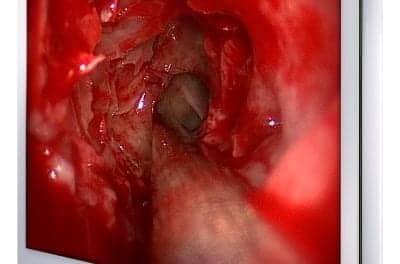
|
| Jason Fought, MD |
Contrast-induced nephropathy (CIN) results from exposure to radiocontrast media, which was administered to more than a million patients in the United States in 2003.1 CIN is typically defined as an increase in serum creatinine of more than 25% above the baseline value, or an absolute increase of 0.5 mg/dL above baseline, and is the third most common cause of in-hospital acute renal failure.2 Morbidity and mortality increase significantly in patients with CIN, as do costs and lengths of hospital stay.3 As patients with chronic diseases are now living longer, populations susceptible to CIN (such as patients with chronic kidney disease and diabetes) are growing, as well. Strategies such as the use of lower-osmolar contrast media, hydration with saline or sodium bicarbonate solutions, and use of N-acetylcysteine to prevent CIN in patients with mild-to-moderate kidney disease have reduced its incidence, but have not eliminated it entirely. In addition, the best way to prevent CIN in patients with severe kidney disease is unknown. New strategies to prevent CIN are currently being evaluated. Some of the most promising include induction of hypothermia, targeted therapy through the renal arteries, the prophylactic use of hemofiltration, and removal of contrast before it reaches the kidney.
Induced Hypothermia
The cause of CIN is multifactorial. Direct nephrotoxicity of radiocontrast, renal medullary ischemia secondary to decreased blood flow, and free-radical formation are all believed to contribute to CIN. In the case of medullary ischemia, adenosine triphosphate (ATP) levels are depleted; if they fall low enough, cell death ultimately results. Hypothermia has been shown to decrease ischemic renal-cell death during renal-artery occlusion lasting 25 minutes in rats.4 In fact, lower serum creatinine levels were found 24 to 48 hours after renal-artery occlusion in rats that were kept hypothermic, compared with rats kept at normal and hyperthermic temperatures. Similar studies5 showed that hypothermia inhibits cellular ATP depletion.
A recent trial6 compared the effects of hypothermia, fenoldopam, sodium bicarbonate, and N-acetylcysteine on renal function in rabbits. The study looked at seven different groups of five to six rabbits each. The control group was normothermic at 39°C, while three other groups were kept at temperatures of 37°C, 35°C, and 32°C. These groups received no other prophylaxis. The other three groups were normo-thermic and received either N-acetylcysteine before and for 3 hours after contrast administration, fenoldopam before and for 3 hours after contrast administration, or sodium bicarbonate before and for 6 hours after contrast administration. Serum creatinine was measured at baseline, after 24 hours, and after 48 hours to define the degree of renal insult. The results showed that the hypothermic rabbits had little or no change in their serum creatinine levels, while the bicarbonate, fenoldopam, and N-acetylcysteine groups had increases in serum creatinine both 24 and 48 hours after contrast administration. Tissue histology showed not only that hypothermia prevented an increase in creatinine, but also that cooling preserved normal cellular structure, a finding not seen in association with the other prophylactic strategies.
A pilot study7 is investigating the effect of inducing hypothermia in patients with significant, chronic kidney disease. Fifty patients with creatinine-clearance levels of 20 to 50 mL per minute who are scheduled to receive at least 50 mL of contrast for coronary catheterization will be given normal saline (1.5 mL/kg per hour) for 2 to 12 hours before catheterization. Subjects’ core body temperatures will be reduced to 33°C to 34°C using an intravenous (IV) cooling balloon, with buspirone, meperidine, and warming blankets used to suppress shivering. Administration of normal saline will continue for 5 to 7 hours after catheterization. Serum creatinine levels will be measured at baseline and 24, 48, and 72 to 96 hours after contrast administration. The study’s primary endpoint is CIN, defined as an increase in serum creatinine of 25% above baseline. To date, 27 patients have been enrolled at seven different sites; their average creatinine clearance has been 34.8±9.1 mL per minute. Average temperature at the time of first contrast administration has been 33.2±0.4°C and has taken approximately 20 minutes to achieve. Average non-ionic contrast volume has been 142±61 mL (range, 49 to 320 mL). Mean serum creatinine was 2.4±-0.9 at baseline and has been essentially unchanged 24, 48, and 72 to 96 hours later. So far, 8.3% of patients in this study have developed CIN. No safety problems have been identified, and a large-scale, randomized, controlled trial of 350 patients is planned to compare hypothermic patients receiving either normal saline or sodium bicarbonate solution to similarly hydrated normothermic controls. Clearly, this is an exciting area that merits further investigation.
Targeted Renal Therapy
Many medications have been tried in an attempt to reduce the incidence of CIN, but they could not be used due to their systemic effects. One example, fenoldopam, seemed especially promising in preventing CIN. As CIN appears to be mediated by decreased blood flow to the renal medulla, a medication that can increase blood flow should be protective. Fenoldopam is a selective dopamine-1 agonist that increases plasma renal flow, decreases intrarenal vascular resistance, and increases glomerular filtration. Due to its selectivity, it does not have the vasoconstrictive effects of dopamine. Studies8 initially showed that fenoldopam was effective in preventing CIN; however, Briguori et al9 compared IV hydration plus 1,200 mg N-acetylcysteine (administered twice daily) to IV fenoldopam in patients undergoing arteriography. These investigators showed a lower incidence of CIN in the N-acetylcysteine group (4.3%) than in the fenoldopam group (13.7%). The randomized, double-blind, placebo-controlled CONTRAST trial10 also showed no benefit for systemic infusion of fenoldopam versus placebo. In this study, there was a minimal effect on glomerular filtration rates, and more than 20% of patients had fenoldopam stopped because of systemic hypotension.
To address this systemic hypotension and to increase concentrations of the drug in the kidneys, targeted renal therapy has been used with fenoldopam. A bifurcated infusion catheter that is easily inserted into both renal arteries allows simultaneous infusion of medication into both arteries and allows first-pass metabolism by the kidney, before the drug reaches the systemic circulation. Smaller doses of medication can be given to patients while higher local concentrations in the kidneys are achieved.
A multicenter, randomized, controlled, open-label clinical trial11 enrolled 33 patients with creatinine clearances of less than 70 mL per minute (or less than 80 mL per minute, for subjects with diabetes) who were expected to receive at least 80 mL of contrast. All patients received 600 mg of oral N-acetylcysteine twice daily and IV saline for 2 hours before the procedure. One group received IV fenoldopam at 0.1 to 0.2 mg/kg per minute, titrated over approximately 75 minutes to the highest dose tolerated. At this point, fenoldopam administration was stopped, and a washout period of at least an hour followed. The renal arteries were then cannulated using the bifurcated infusion catheter and intrarenal fenoldopam was given for 10 minutes prior to catheterization. Fenoldopam administration continued for the duration of the procedure, or a minimum of 30 minutes. The control group received IV dextrose before and during the procedure. The group receiving intrarenal fenoldopam was statistically older than the control group; otherwise, baseline patient characteristics were similar.
Results showed that targeted renal delivery lowered plasma levels of fenoldopam, presumably because of first-pass metabolism. Intrarenal fenoldopam also caused less effect on systemic blood pressure, and the glomerular filtration rate increased 25% over baseline. In comparison, IV fenoldopam increased the glomerular filtration rate only 4.9% over baseline (P<.05 versus control). No patient in either group developed CIN. While these effects are theoretically helpful in preventing CIN, a larger, randomized trial that includes patients with more significant kidney disease is needed to evaluate whether intrarenal fenoldopam truly decreases the incidence of CIN.
Hemofiltration to Prevent CIN
Hemodialysis has been shown to remove radiocontrast from the circulation effectively.12 Several studies13-15 have looked at the effect of hemodialysis in preventing CIN, but have failed to show a decreased incidence of CIN. Because the previous studies started 1 to 2 hours after contrast exposure, Frank et al16 tested whether simultaneous contrast administration and dialysis would decrease the incidence of CIN. Unfortunately, reductions in contrast concentration occur slowly, and the nephrotoxic effects of contrast are thought to happen during initial exposure to it.17 In addition, hemodialysis causes fluid shifts and can transiently decrease renal blood flow, increasing the likelihood of CIN. For these reasons, hemodialysis is no longer considered a viable technique for preventing CIN.
Hemofiltration, on the other hand, has been shown to be effective in preventing CIN in two different trials.18,19 In the first study, Marenzi et al18 performed a prospective, randomized study comparing hemofiltration to saline hydration in 114 patients undergoing coronary angiography. Baseline characteristics for both groups were similar, and the average creatinine clearance was 26 mL per minute. Both hemofiltration and control groups received similar amounts of contrast. Renoprotective drugs were not used in this study. The hemofiltration group underwent hemofiltration at a rate of 1 L per hour for 4 to 6 hours prior to contrast administration, as well as for 18 to 24 hours after the procedure. Isotonic replacement fluid was administered at a rate set to produce no net fluid loss. A loading dose and continuous IV heparin were used in conjunction with hemofiltration. The control subjects were admitted to a stepdown unit and received 0.5 to 1 mL/kg per hour of isotonic saline for 6 to 8 hours before and 24 hours after coronary catheterization.
Only three patients in the hemofiltration group experienced CIN, compared with 28 patients in the control group (P<.001). Emergency hemodialysis was required by 18% of the control group (10 patients) and by none of the patients receiving hemofiltration. The in-hospital mortality was significantly lower in the hemofiltration group (2%) than in the control group (14%, P=.02). A significant decrease (P=.01) in 1-year mortality was also seen for the hemofiltration group.
A follow-up study by Marenzi et al19 evaluated 92 patients with creatinine clearances of 30 mL per minute or less and placed them in one of three groups. The control group (30 patients) received 1 mL/kg of isotonic saline for 12 hours before and after contrast exposure. The second group (31 patients) received the same IV fluids before contrast, but received hemofiltration for 18 to 24 hours after contrast exposure. Hemofiltration was set at a rate of 1 L per hour and matched to ultrafiltrate production to achieve no net fluid loss or gain. The third group underwent hemofiltration for 6 hours before the procedure, as well as for 18 to 24 hours after contrast exposure. The study’s primary endpoint was CIN, while the secondary endpoint consisted of in-hospital adverse events. CIN was defined as a greater than 25% increase in serum creatinine from baseline or an absolute increase of 0.5 mg/dL. Baseline clinical characteristics were not statistically different among the groups.
While 12 patients (40%) in the control group and eight patients (26%) in the postcontrast hemofiltration group experienced CIN, only one patient in the precontrast and postcontrast hemofiltration group developed CIN (P=.0013). In addition, nine patients (30%) in the control group needed emergency hemodialysis or hemofiltration, compared with three (10%) in the postcontrast hemofiltration group and none in the precontrast and postcontrast hemofiltration group. Nine patients in the study died while hospitalized; six were in the control group, three were in the postcontrast hemofiltration group, and none were in the precontrast and postcontrast hemofiltration group. All of the deaths were due to cardiovascular events.
These two studies showed significant benefits and promise for patients with severe, chronic kidney disease who receive radiocontrast. Interpretation of the positive outcomes for CIN incidence, however, requires caution. Hemofiltration, by itself, will remove creatinine from the body, due to the nature of the procedure. Despite this, the differences seen in emergency hemodialysis rates, in-hospital mortality, and 1-year mortality are impressive. Perhaps the benefit is mediated by sodium bicarbonate given during hemofiltration, or even an effect on body temperature. Additional research is needed to understand the mechanism that creates the benefit of this procedure.
Ultimately, as long as patients with risk factors for CIN are exposed to radiocontrast, the likelihood of renal injury will be present. Another novel approach is to remove contrast before it even reaches the kidney. In pilot studies in canines, coronary sinus catheterization was used with a venous capture device that automatically sensed and removed up to 88% of radiocontrast that came from injections in the coronary arteries (M. Meyer, MD, oral communication, May 2006) Such devices would not necessarily be limited to use in the coronary arteries, or even to use with radiocontrast. They could, for example, remove toxic chemotherapeutic agents from an organ’s circulation before the drug reached the systemic circulation.
SUMMARY
There are many new approaches to preventing CIN that warrant further evaluation. Whether induced hypothermia, targeted renal therapy, hemofiltration, or contrast capture will prove effective in larger, randomized, controlled clinical trials and become the standard of care remains to be seen. Regardless, the volume of procedures requiring contrast continues to increase, and patients are living longer with diseases that predispose them to CIN. Because of this, better ways to prevent CIN effectively should continue to be a focus within the medical community.
Jason Fought, MD, is clinical instructor of medicine, University of Vermont School of Medicine and senior fellow, division of nephrology, Fletcher Allen Health Care, Burlington, Vt.
REFERENCES
- Wiechmann BN. Contrast-induced nephropathy: a brief review and looking forward. Vascular Disease Management. 2006; March/April suppl:2-5.
- Nash K, Hafeez A, Hou S. Hospital acquired renal insufficiency. Am J Kidney Dis. 2002;39:930-936.
- Best PJ, Lennon R, Ting HH, et al. The impact of renal insufficiency on clinical outcomes in patients undergoing percutaneous coronary interventions. J Am Coll Cardiol. 2002;39:1113-1119.
- Zager RA, Altschuld R. Body temperature: an important determinant of severity of ischemic renal injury. Am J Physiol. 1986;251:F87-F93.
- Zager RA, Gmur DJ, Bredl CR, Eng MJ. Temperature effects on ischemic and hypoxic renal proximal tubular injury. Clin Invest. 1991;64:766-776.
- Dae MW, Gao DW, Stillson CA, Ursell PC. Hypothermia, but not N-acetylcysteine or fenoldopam, prevents experimental contrast-induced nephropathy. J Am Coll Cardiol. 2004;43(suppl A) Poster presentation at ACC 2004.
- Stone GW. Induced hypothermia to prevent contrast nephropathy. Paper presented at: Transcatheter Cardiovascular Therapeutics; October 21, 2005; Washington, DC.
- Kini AS, Mitre CA, Kim M, Kamran M, Reich D, Sharma SK. A protocol for prevention of radiographic contrast nephropathy during percutaneous coronary intervention: effect of selective dopamine receptor agonist fenoldopam. Catheter Cardiovasc Interv. 2002;55:169-173.
- Briguori C, Colombo A, Airoldi F, et al. N-acetylcysteine versus fenoldopam mesylate to prevent contrast agent-associated nephrotoxicity. J Am Coll Cardiol. 2004;44:762-765.
- Stone GW, McCullough PA, Tumlin JA, et al. Fenoldopam mesylate for the prevention of contrast-induced nephropathy: a randomized controlled trial. JAMA. 2003;290:2284-2291.
- Teirstein PS, Price MJ, Mathur VS, Madyoon H, Sawhney N, Baim DS. Differential effects between intravenous and targeted renal delivery of fenoldopam on renal function and blood pressure in patients undergoing cardiac catheterization. Am J Cardiol. 2006;7:1076-1081.
- Schindler R, Stahl C, Venz S, Ludat K, Krause W, Frei U. Removal of contrast media by different extracorporeal treatments. Nephrol Dial Transplant. 2001;16:1471-1474.
- Vogt B, Ferrari P, Schonholzer C, et al. Prophylactic hemodialysis after radiocontrast media in patients with renal insufficiency is potentially harmful. Am J Med. 2001;111:692-698.
- Berger E, Bader BD, Bosker J, Risler T, Erley CM. Contrast media-induced kidney failure cannot be prevented by hemodialysis. Dtsch Med Wochenschr. 2001;126:162-166.
- Lehnert T, Keller E, Gondolf K, Schaffner T, Pavenstadt H, Schollmeyer P. Effect of hemodialysis after contrast medium administration in patients with renal insufficiency. Nephrol Dial Transplant. 1998;13:358-362.
- Frank H, Werner D, Lorusso V, et al. Simultaneous hemodialysis during coronary angiography fails to prevent radiocontrast-induced nephropathy in chronic renal failure. Clin Nephrol. 2003;60:176-182.
- Russo D, Minutolo R, Cianciaruso B, Memoli B, Conte G, De Nicola L. Early effects of contrast media on renal hemodynamics and tubular function in chronic renal failure. J Am Soc Nephrol. 1995;6:1451-1458.
- Marenzi G, Marana I, Lauri G, et al. The prevention of radiocontrast-agent-induced nephropathy by hemofiltration. N Engl J Med. 2003;349:1333-1340.
- Marenzi G, Lauri G, Campodonico J, et al. Comparison of two hemofiltration protocols for prevention of contrast-induced nephropathy in high risk patients. Am J Med. 2006;119:155-162.






